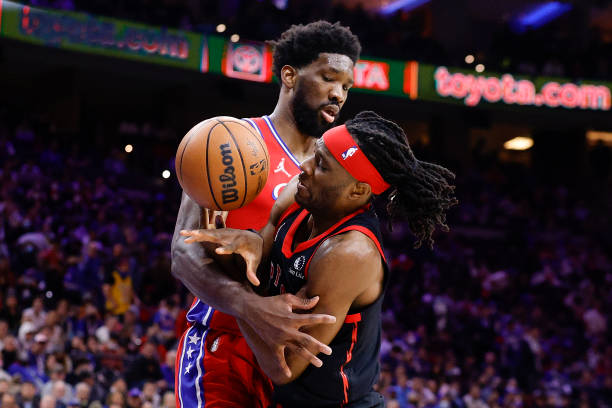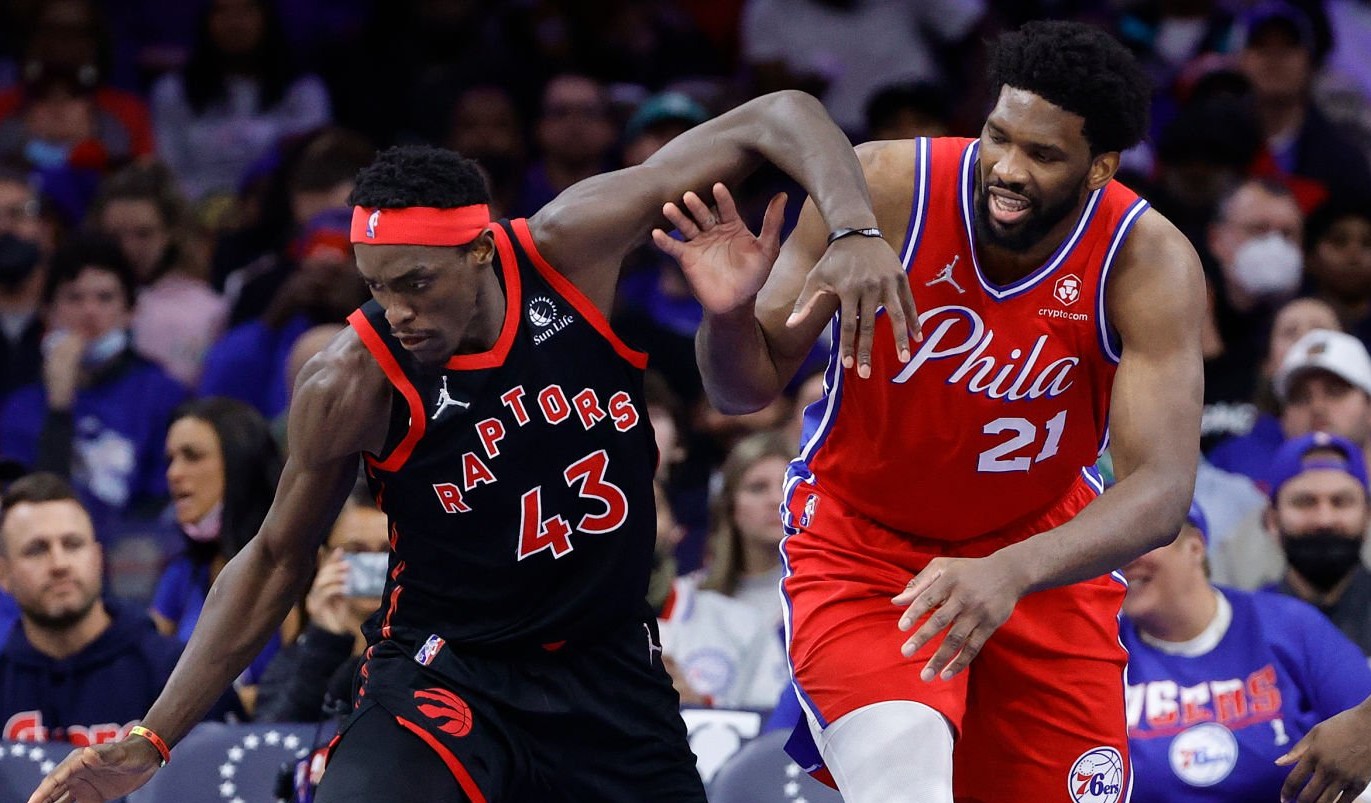There are many ways to die, you mutter to yourself. Or maybe you just thought it. You’ve been hearing voices recently. But you can die by outright violence, by hack and slash, overpowered to the last breath. You shiver, remembering the mangled, scarred corpse from the other night. You look down at the same body, lying crooked on the same pavement, the same mist drifting in your sight, the same wounds now in duplicate. Everything: the same. You remember the same body dusting itself off after your autopsy, wandering off into the morning. Maybe, you think to yourself, it never really survived the beating. Maybe the chalk outline walked away with it. Yes, you mutter, this time definitely out loud, there are many ways to die.
This time the wounds on the body of the Toronto Raptors are somehow less jarring even if they’re doubled in number, fresh oozes cutting over top of scars only just healed, mirrored in pattern and in ghastly intent. Even your nausea is familiar to you. You can trace the scars and your reactions both like the life lines on the palms of your hands. A cavalcade of free throws caving in the chest like a blow from a hammer? Yes. You’ve seen that. Tyrese Maxey drives? Tobias Harris threes? Yes, yes. You can picture the injuries with your eyes closed.
But no, none of those were the causes of death. You know exactly what killed the Toronto Raptors, and you know it intimately, a shadow, a ghost you recognize in the mirror in your most vulnerable moments, when the pack is empty and the bottle is dry and you’re too weak to close your eyes and too scared to open them. It’s malaise, thicker than the air you can’t take into your lungs when it hits. And you know without even looking at the crime scene, investigating the wounds and clues, it was the cause of death.
The Raptors weren’t broken, not right away. They scored the game’s first eight points. There was pride and intent, attention to detail. They hit threes, attacked rotations, switched pick and rolls, forced misses. Then came a parade of fouls, and even if they were mostly fine calls in isolation, they sure felt funny all added together. You know how mostly fine decisions can add up to something less than that; you’re here, after all, staring into eyes that can’t stare back, that you’ve seen in your dreams and your waking hours, on your television and computer screen, for years, mostly likely. You’re a Toronto Raptors fan. You know exactly what brought you here.
And the Raptors weren’t beaten, not right away. Maybe in that first quarter after the leering parade of fouls blocked off Main Street — don’t blame us, we have the permits! — Toronto was the Coyote, already off the edge of the cliff but still running, not looking down. Toronto won the first quarter by a point, hanging on, still running in midair but legs slowing, churning, the air thickening to water, to butter, to manacles.
It fell apart in the second quarter, the Raptors running, sure, but just as much energy was spent falling. First they traded baskets with the Sixers, then they threw some turnovers, and wasted a needless challenge, and before long the game was out of reach. It’s simple, you see written in symbology on the body at your feet, but the wounds are internal this time. Would be invisible if you didn’t know exactly where to look. The Sixers won the game when Joel Embiid was on the bench, the punch coming when the Raptors least expected it. When the body wasn’t braced. That’s what killed Houdini, you read once. That’s what killed the Raptors. Sure, why not. But no, that shoe doesn’t fit. You know what killed them, and it wasn’t contact — it was the reaction to the contact, the fold, the crumple. The no más to make the punches stop coming.
Wait til you see the other guy, you think wryly. That didn’t occur to you last time. Last time, when three Raptors were hit in the face and two suffered sprained ligaments. Nick Nurse and the Raptors discussed matching Embiid’s physicality in between games, not backing down from the challenge. Axioms that all translate, in this case, to hitting a guy before he hits you. Whoever throws the first punch wins the fight. All that jazz. And the Raptors made sure to throw the first punch in this battle. Embiid suffered bumps and bruises and even a banged elbow. The only problem was that each and every one of them (and maybe even a few more for good measure) were called fouls. Embiid attempted 12 free throws in the first quarter, the second-most in recorded NBA history. So sure, the other guy certainly has some marks on him. But nothing like what you see, you muse to yourself, as you look down at the body in front of you. Perhaps the other guy even has more bruises, but he doesn’t look anything like this.
“We tried our best to defend,” said OG Anunoby after the game. “The refs were calling fouls. We can’t do anything about that.”
When they fell, they fell. No Looney Tunes drop out of sight, impact imagined, softened by a sound track that promises survival. You saw it in real time: The revolution will be televised. You don’t even need the notebook. You watched the murder right in front of you. You saw the third quarter, the start of it, Pascal Siakam missing three point-blank layups, Precious Achiuwa and Anunoby turning the ball over, the lead 20 before warmup jerseys were off, the same feeling as being late for work before your alarm clock even rings.
The mist swirls around you, and you wave your hand for something to do. There’s no real investigation to be done, not this time. The mist swirls but doesn’t clear, and you see pictures written in the vapour, like watching clouds. You see Toronto rediscovering its identity, taking 20 more field goal attempts than Philadelphia. But you know that’s a lie. Philadelphia attempted 30 free throws — they would be shots had the Raptors not fouled, had the whistles not blown. Toronto grabbed 13 offensive rebounds, but many came late, and many didn’t result in makes anyway. They forced only 14 turnovers. The Raptors remain wandering in the desert, any sense of them finding their identity a mirage, a picture in the mist.
“You can just put the blame on me,” said VanVleet after the game. He shot five of nine in the first quarter that the Raptors won and two of 14 the rest of the way. If the Raptors have a heart, it’s VanVleet. It’s not torn out of the chest cavity, beating lifeless on the pavement, subsisting on electric pulses. Not yet. But you can see it in the mist.
You know how this ends. Your cigarette is smoked so low your fingers singe, you reveling in feeling something, anything, but you finally flick it away and straighten up. You put your notebook back in the pocket, a corner torn from the last page of notes for your filter. You see the corpse stand, again, brush the hurts, real and imagined, from its shoulders. Again. Maybe there’s some pride straightening the poor necromantic creation’s spine, a hint of joy from a 20-2 run in the fourth quarter. But it still hunches, even the comeback halted by an airballed step-back three from Chris Boucher. Boucher, who played best in Toronto’s loss. Even the proudest performances are marred by the corruption of losses like that. Pride only hurts; it never helps.
You mutter more things to yourself. It’s a development season, after all. Scottie Barnes is going to be more powerful than anyone can imagine. But that’s in the future. And your pain, the body’s pain, is in the now. This is fandom, the good and the bad. The future is written in mist. Soon the future will be the thing that’s real, and this vision of a harrowed corpse limping towards its next engagement will be the mist, the memory, the dream. You play with the two visions, weigh them in your mind, your heart. The hurt and the hope, the ennui and the expectation. If you focus hard enough, you might not remember what’s real and what’s imagined. Maybe the voices in your head can convince you. You walk away from the scene of the crime, heading in any direction but the one the corpse took. You need a minute away. You’ll watch it battle again soon, too soon. Who knows what pictures in the mist you’ll see, or think you see, then?



